Ohio Field Station
The Wildlife Services program provides leadership and expertise to help resolve wildlife conflicts to allow people and wildlife to coexist. The NWRC Ohio Field Station plays a unique role in understanding animal-vehicle collisions, especially wildlife hazards to aircraft and how wildlife species use airport environments. Its efforts aid in the development of management methods to reduce wildlife hazards to aviation which helps to protect both people and wildlife.
Aircraft collisions with birds and other wildlife (wildlife strikes) pose a substantial safety and financial threat to civil and military aviation worldwide, causing millions of dollars in damages annually in the U.S. and abroad. Globally, wildlife strikes killed more than 301 people and destroyed over 298 aircraft from 1988 through 2021. As one dramatic example, in 1995 a U.S. Air Force $190 million AWACS plane crashed, resulting in the death of 24 crewmembers and the destruction of the plane after the aircraft hit geese on take-off at Elmendorf Air Force Base, AK. The "forced landing" of US Airways Flight 1549 in the Hudson River on January 15, 2009, after Canada geese were ingested in both engines on the Airbus 320, also demonstrated to the public that bird strikes are a grave concern to aviation safety. For the 34-year period (1990-2023), 296,613 strikes were reported of which 291,547 (98.3 percent) occurred in the USA.
The NWRC Ohio Field Station works with the Federal Aviation Administration (FAA), the U.S. Department of Defense, universities, and Wildlife Services biologists to develop management strategies to reduce wildlife hazards to aircraft and produce science-based recommendations, policies, and procedures to control hazardous wildlife on airports and other locations where they present a hazard to aviation safety.
Considerable field research on bird species associated with aviation safety concerns and other wildlife damage can be conducted within 60 miles of the field station. Ohio has the highest breeding season population of blackbirds and starlings of any state or province, and marshes along Lake Erie are traditional late-summer congregating places for these birds. One of the largest nesting colonies of herring gulls on the Great Lakes is within 8 miles of the field station, and a major proportion of the continental population of ring-billed gulls concentrates along the south shore of Lake Erie in spring and fall. Large concentrations of fish-eating birds, such as double-crested cormorants, also congregate on Lake Erie during migration. Furthermore, Ohio, including its areas close to Lake Erie, hosts growing populations of Turkey and Black vultures.
Facility
The NWRC Ohio Field Station, established in 1968, is located 4 miles south of Sandusky, OH, and Lake Erie at the Neil Armstrong Test Facility , a 6,000-acre, fenced facility in Erie County operated by Glenn Research Center, National Aeronautics and Space Administration (NASA). The restricted-access facility contains native grassland, reverted farmland, marsh, and woodland adjacent to intensively farmed land and urban settings outside the fence. Abundant wildlife populations can be found on the facility; for example, the deer population inside the fence can exceed 2,000 individuals. Field station facilities include indoor and outdoor aviaries, several permanent bird-traps, drying and processing rooms for field samples, shop space, a video laboratory for behavioral experiments, a 5-acre fenced pond for waterfowl research, and conference rooms.
Further information about the research conducted at the Sandusky, OH field station can be found on the Aviation Safety Research page.
Ohio Field Station History
The NWRC Ohio Field Station (OFS) was created in 1968 by the U.S. Department of the Interior, Fish and Wildlife Service, to be administered as a part of the Animal Damage Control (ADC) program and in response to calls from Ohio farmers concerning wildlife damage to their crops. Dr. Mel Dyer arrived in the same year from the University of Guelph, Ontario, to take charge of the field station. The focus of research for the OFS staff was bird damage to agriculture, primarily damage to corn crops by blackbird species and invasive European starlings.
In 1972, Dr. Richard Dolbeer took over leadership of the OFS and continued to guide its efforts on management of bird damage to agriculture. By the 1980s, he and his team also began to address a new, burgeoning human-wildlife problem area—bird collisions or “strikes” with aircraft. By 1976, all ADC research was consolidated under the Denver Wildlife Research Center. In 1985, the ADC program and the OFS were transferred to the U.S. Department of Agriculture’s Animal and Plant Health Inspection Service. The field station was one of seven other field research facilities under Denver Wildlife Research Center, now the National Wildlife Research Center located in Fort Collins, CO.
By 1989, Dr. Dolbeer’s actions to understand and prevent bird strikes led to the first of a long series of five-year Interagency Agreements between the Federal Aviation Administration and ADC, now known as Wildlife Services. By the early 2000s the OFS was the recognized world leader in research to mitigate wildlife hazards to aviation safety.
Ohio Field Station Today
The NWRC Ohio Field Station’s (OFS) team of researchers and support staff generates and disseminates ecological information related to wildlife collisions with vehicles and structures, including civil and military aircraft. This goal comprises 3 objectives:
- understand/quantify animal sensory ecology and animal behavioral responses to risk, like predation risk, to reduce wildlife collisions,
- understand/quantify the role of unmanned aircraft systems (UAS) in wildlife monitoring and hazing, and
- understand/quantify airspace and landscape use of birds near airports to reduce the probability of an aircraft strike.
To meet these objectives, OFS scientists conduct lab and field experiments, many of which are carried out in northern Ohio.
Our offices and facilities on the 6,000-acre Neil Armstrong Test Facility (NATF) in Sandusky allow us opportunities to work with free-ranging bird and mammal species. Some of our research questions, however, cannot be answered using the facilities at the NATF, simply because of the need for research on actual airports or that our facility is not used extensively by some species of interest (e.g., gulls and vultures). Through collaborations with stakeholders and the Wildlife Services’ State operations program, we have conducted research on local areas, such Ottawa National Wildlife Refuge, Old Woman Creek State Nature Preserve and National Estuarine Reserve, Cedar Point Amusement Park, Erie County Landfill, and airports and military airfields in Cleveland, Dayton, and Toledo.
The OFS staff also collaborate with government and university partners. Over the years our collaborations have included the Federal Aviation Administration, Department of Defense, State fish and wildlife agencies (especially the Ohio Division of Wildlife), Auburn University, Indiana State University, Michigan State University, Mississippi State University, North Carolina State University, the Ohio State University, Purdue University, University of Illinois, the University of Georgia, and a variety of international government and nongovernmental entities, as well as foreign universities. Importantly, wildlife research is effective at improving our understanding of our wildlife resources and guiding management only when it is objectively scrutinized. OFS scientists submit their research findings to peer-reviewed, professional, scientific journals where they receive critical review from other researchers. This peer-review process is the gold standard by which our research can effectively inform wildlife management methods and decisions.
The OFS staff have expertise in avian visual ecology and implications for aircraft lighting design intended to enhance bird detection of and response to approaching aircraft; raptor movement ecology as related to strike hazards posed to civil and military aircraft operations; and UAS applications to wildlife management, including non-lethal methods to move wildlife from areas of conflict, as well as use of this new technology to count birds and mammals in the airport environment. These research areas necessitate collaborative team approaches to generate solutions to problems. Research by the OFS staff subsequently informs management on civil and military airfields, as well as public entities and resources, like landfills, that affect wildlife use and human health and safety.
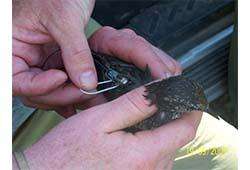
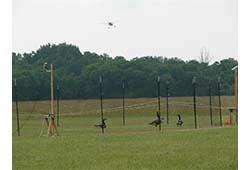
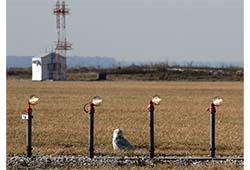
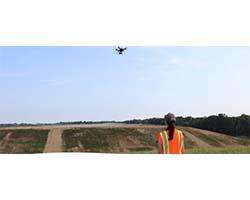
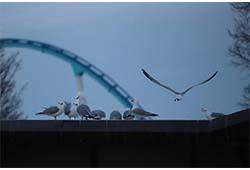
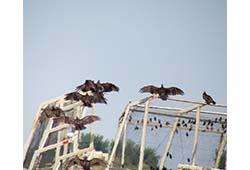
Researchers from the NWRC Ohio Field Station use very high frequency (VHF) radio tags to track the movements of European starlings among agricultural areas and roosts.
Photo credit: USDA WS
A large, radio-controlled aircraft approaches a flock of Canada geese. The aircraft is equipped with full-spectrum LED lighting, operating with either lights off or LEDs pulsing at 2 HZ, to evaluate if lighting can enhance the birds’ abilities to detect and respond to the approaching aircraft. Findings indicate that aircraft lights tuned to the species’ visual capabilities can enhance detection and avoidance behaviors.
Photo credit: USDA WS
Contact Us
Ohio Field Station
Bradley F. Blackwell, PhD, Field Station and Project Leader
Ohio Field Station
6100 Columbus Avenue
Sandusky, Ohio 44870
Brian Washburn, Research Biologist
Morgan Drabik-Hamshare, Research Wildlife Biologist
Dave Grayson, Wildlife Technician
Betsy Poggiali, Budget Technician
Bruce Buckingham, Wildlife Technician







